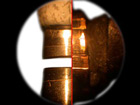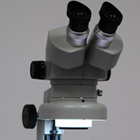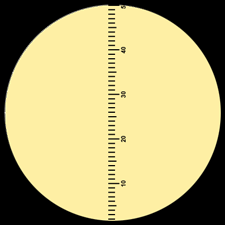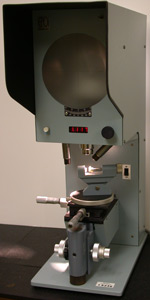Home | Glossary | Resources | Help | Contact Us | Course Map
Archival Notice
This is an archive page that is no longer being updated. It may contain outdated information and links may no longer function as originally intended.
Comparison Microscope
The air gap method can be used to measure land and groove impressions.
Using a comparison microscope:
- Place a fired evidence bullet on a bullet mount on one stage of the comparison microscope.
- Mount the micrometer, jaws up, on the other stage.
- Set the objective lenses for both stages to the same magnification.
- Focus both lenses.
- Open the jaws of the micrometer to match the reference points on the fired bullet.
- Record reading (air gap) to the nearest thousandth of an inch.
- Rotate the bullet to the next land or groove impression.
- Repeat steps 4 - 7 until all land and groove impressions are measured.
Stereomicroscope
Using a stereomicroscope land and groove impressions can me measured as follows,
- Place a fired evidence bullet and the micrometer under the microscope.
- Open the jaws of the micrometer to match the reference points on the fired bullet.
- Record the reading to the nearest thousandth of an inch.
- Rotate the bullet to the next land or groove impression.
- Repeat steps 2 - 4 until all land and groove impressions are measured.
Reticules
Glass
The process for measuring land and groove impressions with a glass reticule is as follows:
- Place the bullet on a fixed mount that can be rotated.
- Rotate the bullet to the selected land or groove impression.
- Bring both reference points into focus.
- Superimpose the measuring grid of the eyepiece on the surface of the bullet.
- Take a measurement reading to the nearest thousandth of an inch.
- Rotate the bullet to the next land or groove impression and repeat steps 3 5.
It is important to note that both of the eyepieces of the microscope must be adjustable to use this technique.
Electronic
The steps for measuring land and groove impressions using electronic reticules are the same as those for glass reticules.
Digital Equipment
MP 6 Optical Projector
The process for measuring land and groove impressions with an optical projector is as follows:
- Mount the nose of a bullet on a moveable stage - the bullet image is projected onto a hooded screen that displays a measuring grid.
- Bring both edges of the selected land or groove impression into focus.
- Align one reference point on the impression with a line on the measuring grid - the reference point is designated as zero.
- Move the bullet and its mount by rotating the knob until the next reference point is reached the width of the land or groove impression is displayed in an LED readout in thousandths of an inch.
- Rotate the bullet on its mount to the next land or groove impression.
- Repeat steps 2-5 until all land and groove impressions are measured.
FBI GRC File Standards
The FBI GRC file is a collection of well-documented, known GRC data that can be used as a standard for comparison of class characteristics of no-gun submission evidence bullets. The GRC digital database file can be searched electronically or in print form.
The general rifling characteristics derived from a fired evidence bullet are an indication of the brand(s) and model(s) of firearm from which the bullet could have been fired.
The data obtained from a fired bullet provides the input data for searching the GRC file, including
- caliber,
- number of lands and grooves,
- direction of twist,
- land and groove impression measurements,
- other information.
The examiner must use experience, skill, and judgment to determine and refine the parameters of the search criteria entered into the GRC file. The GRC search produces a list of potential firearms from which the bullet could have been fired.
Additional Online Courses
- What Every First Responding Officer Should Know About DNA Evidence
- Collecting DNA Evidence at Property Crime Scenes
- DNA – A Prosecutor’s Practice Notebook
- Crime Scene and DNA Basics
- Laboratory Safety Programs
- DNA Amplification
- Population Genetics and Statistics
- Non-STR DNA Markers: SNPs, Y-STRs, LCN and mtDNA
- Firearms Examiner Training
- Forensic DNA Education for Law Enforcement Decisionmakers
- What Every Investigator and Evidence Technician Should Know About DNA Evidence
- Principles of Forensic DNA for Officers of the Court
- Law 101: Legal Guide for the Forensic Expert
- Laboratory Orientation and Testing of Body Fluids and Tissues
- DNA Extraction and Quantitation
- STR Data Analysis and Interpretation
- Communication Skills, Report Writing, and Courtroom Testimony
- Español for Law Enforcement
- Amplified DNA Product Separation for Forensic Analysts






